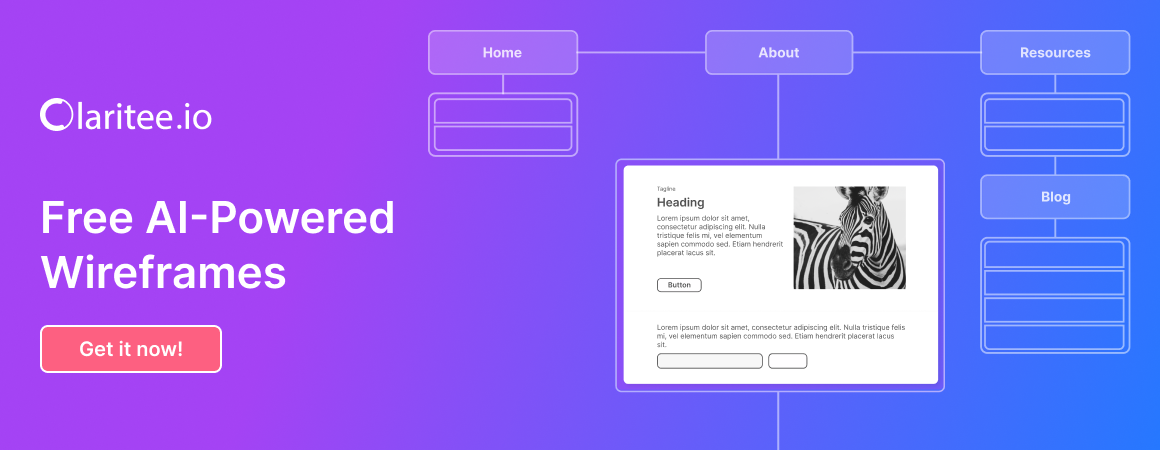A “user flow” isn’t one thing. It’s a process. The tool you need for a messy, creative brainstorm is different from the tool you need for mapping complex technical logic. And both of those are different from the tool you need to get a final, contractual client sign-off.
Using the wrong tool for the job is a critical mistake. Using a brainstorming tool (like Miro) for a final approval is a recipe for scope creep.
Here is our review of the top user flow tools, broken down by the job they are actually built for.
The Top User Flow Tools for Every Task
1. Claritee: Best for Auditable Client Approvals
This is Claritee’s non-negotiable value. It’s the only platform that combines visual flows with a “decision-rememberance” portal.
- Best For: Getting a final, formal, auditable sign-off from clients and stakeholders.
- Why: Claritee is a “visual contract” platform. Its flows are integrated into a visual sitemap, and each step can contain its own lo-fi wireframe. The killer feature is the ‘no-login’ share link that allows a client to formally click “Approve,” creating a permanent, timestamped audit-trail.
- Weakness: It’s not an infinite, “messy” canvas for a 50-person brainstorm. It’s structured for clarity and accountability.
2. Miro / Mural: Best for Team Brainstorming & Workshops
These are the kings of the digital whiteboard, and their strength is in pure, unstructured ideation.
- Best For: Messy, creative, “Stage 1” workshops, user journey mapping, and collaborative brainstorming.
- Why: The infinite canvas is a perfect “sandbox.” It’s great for getting ideas out, clustering sticky notes, and facilitating a live, remote team session.
- Weakness: It is not a system of record. It has zero accountability or formal approval features. It’s a “living document” that should never be considered a “final” blueprint.
3. Lucidchart / Visio: Best for Technical & Complex Logic Flows
These are powerful, technical diagramming tools. They are the “engineers” of this list.
- Best For: Mapping complex “if-then” logic, app architecture, or enterprise-level process flows where detail and precision are key.
- Why: Their strength is in their “smart diagramming,” with layers, customizable shapes, and data-linking. They are built to communicate complexity clearly.
- Weakness: They are “dumb” documents. They are static, disconnected from requirements, and have no approval system. An exported PDF is not an audit-trail.
4. Overflow: Best for High-Fidelity Presentations
Overflow is a specialized tool built to make your finished designs look amazing.
- Best For: Turning your polished Figma or Sketch screens into a beautiful, clickable, interactive presentation for stakeholders.
- Why: It excels at “telling the story” of your design. It syncs from your design tools and creates an impressive, navigable flow.
- Weakness: It’s a “last step” tool. You can’t plan or wireframe in it, and it has no formal approval system. It’s for presenting, not for planning or approving.
5. Whimsical: Best for Quick, Standalone Diagrams
Whimsical is popular because it is fast, elegant, and has a minimal learning curve.
- Best For: Creating a quick, standalone user flow or diagram, often for a quick internal presentation or brainstorm.
- Why: It’s clean, simple, and web-based.
- Weakness: It’s an ideation tool, not a professional alignment tool. Its speed comes at the cost of robustness.
- Lacks Integration: Its wireframes and sitemaps are just items on a canvas, not a deeply integrated, hierarchical system like you’d find in Claritee.
- Lacks Customization: It’s built for speed and simplicity, which means it has limited customization for detailed, professional-grade wireframing.
- Lacks Accountability: Like the other ideation tools, it has no formal approval audit-trail. It’s a sketch, not a blueprint.
⭐ Recommendation: Use the Right Tool for the Job
Your workflow is broken.
You’re using one tool for a messy brainstorm (Miro), another for a static diagram (Lucidchart), and another for a simple presentation (Overflow). This is a stack of disconnected “drawing” tools, none of which are connected to your sitemap, your actual requirements, or a formal approval system. This is what creates chaos, developer-designer conflict, and scope creep.
A professional workflow demands a single, integrated platform.
Claritee is the only tool that combines a robust user flow builder with a “smart” visual sitemap (where each step can hold its own fully-custom, detailed wireframe) and then adds the non-negotiable formal approval audit-trail on top.
It’s not just another tool for your stack—it’s the platform that replaces the chaos of your stack with a single, auditable “visual contract.”

